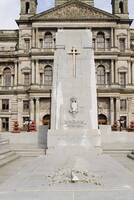| dc.coverage.spatial | Site: Glasgow, Scotland, United Kingdom | en_US |
| dc.coverage.temporal | 1921-1924 (creation) | en_US |
| dc.creator | Burnet, John James | en_US |
| dc.creator | Gillick, Ernest George | en_US |
| dc.date | 1921-1924 | en_US |
| dc.date.accessioned | 2013-10-03T14:45:29Z | |
| dc.date.available | 2013-10-03T14:45:29Z | |
| dc.date.issued | 1921-1924 | en_US |
| dc.identifier | 237071 | en_US |
| dc.identifier.other | archrefid: 2591 | en_US |
| dc.identifier.uri | http://hdl.handle.net/1721.3/144822 | |
| dc.description | Detail, central plinth of monument; A cenotaph is literally an "empty tomb" or a monument erected in honor of a person or group of people whose remains are elsewhere. The Glasgow Cenotaph was designed by JJ Burnet and originally built to commemorate Glaswegians killed in the First World War when it was erected in 1922 by the Earl Haig Fund. The lions and figure of St. Mungo were sculpted by Ernest George Gillick. The lions show Art Deco influence. Source: Wikipedia; http://en.wikipedia.org/wiki/Main_Page (accessed 6/21/2012) | en_US |
| dc.format.medium | stone | en_US |
| dc.rights | © Scott Gilchrist, Archivision, Inc. | en_US |
| dc.subject | animal | en_US |
| dc.subject | death or burial | en_US |
| dc.subject | funerary art | en_US |
| dc.subject | military or war | en_US |
| dc.subject | World War, 1914-1918 | en_US |
| dc.subject | lions | en_US |
| dc.subject | war memorials | en_US |
| dc.subject | Twentieth century | en_US |
| dc.title | Glasgow Cenotaph | en_US |
| dc.type | image | en_US |
| dc.rights.access | Licensed for educational and research use by the MIT community only | en_US |
| dc.identifier.vendorcode | 1A2-SC-G-GC-A2 | en_US |
| vra.culturalContext | British Scottish (Scots) | en_US |
| vra.technique | carving (processes), construction (assembling) | en_US |
| vra.worktype | monument | en_US |
| vra.worktype | cenotaph | en_US |
| dc.contributor.display | Ernest George Gillick (British sculptor, 1874-1951); John James Burnet (British architect, 1857-1938) | en_US |


